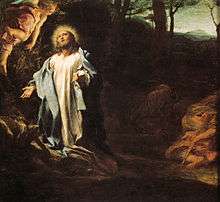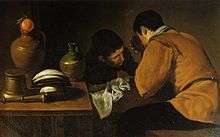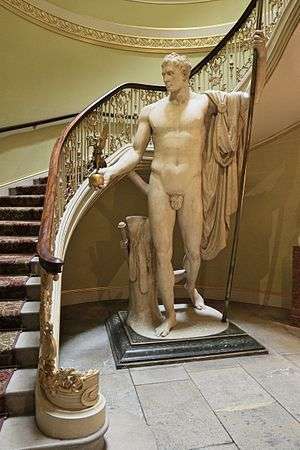Wellington Collection
The Wellington Collection is a large art and militaria collection housed at Apsley House in London. It mainly consists of paintings, including 83 formerly in the Spanish royal collection, given to Arthur Wellesley, 1st Duke of Wellington, who was Prime Minister as well as the general commanding the British forces to victory in the Napoleonic Wars. It also includes his collection of furniture, sculpture, porcelain, the silver centrepiece made for him in Portugal around 1815, and many other artworks and memorabilia relating to his career.
Gerald Wellesley, 7th Duke of Wellington, gave the house and its most important contents to the nation in 1947, but the Wellington Museum Act that year established the family's right to occupy just over half the house "so long as there is a Duke of Wellington".[1] The Wellington Collection, along with the house, is managed by English Heritage and is open to the public.[2]
List of paintings




The notable collection of over 200 paintings on display includes 83 paintings from the Spanish royal collection. At the Battle of Vitoria in northern Spain in 1813, the British army captured a carriage full of paintings from the Spanish royal collection.[3] Joseph Bonaparte, whose brother Napoleon had made him King of Spain, had already lost Madrid, escaping with over 200 paintings in the carriage. Most had been removed from their frames and were rolled up in a large "imperial" or travelling-chest, along with state papers, love letters, and other documents. After a quick look, Wellington and his staff thought there was nothing very important or valuable in it, but sent the imperial by sea to his brother William, Lord Maryborough (as he then was) in London for a proper check. His brother called in William Seguier, later the first keeper of the National Gallery, who recognised the quality of the paintings and compiled a list of 165 of the most important.[4]
Wellington then informed the court of the restored Bourbon King Ferdinand VII of Spain of the incident, to make arrangements for their return, but the king said Wellington should keep them as a gift.[5] The Arnolfini Portrait by Jan van Eyck was also in the carriage, but (being conveniently small) appears to have been looted by the soldiers, and next appeared in London in 1816 in the possession of a Scottish colonel who had been at Vitoria.[6]
Not all the paintings acquired by the first Duke have been on public display. For example, Danaë, an important painting by Titian, long thought to be a copy, was kept in part of the house not open to the public. Danaë and two other Titians reattributed at the same time were briefly put on public exhibition, for the first time, in 2015.[7]
The painting collection includes work by:[8]
American School
British School
Dutch School
- Pieter de Hooch
- Jan van Huysum
- Nicolaes Maes
- Willem van Mieris
- Antonis Mor
- Aernout van der Neer
- Adriaen van Ostade
- Cornelius van Poelenburgh
- Jan Steen
- Willem van de Velde the Younger
- Jan Victors
Flemish School
- Paul Brill
- Adriaen Brouwer
- Jan Brueghel the Elder
- Anthony van Dyck
- Antony Francis van der Meulen
- Rubens
- David Teniers the Younger
French School
- Claude Lorrain
- Claude-Joseph Vernet
- Robert Lefèvre
German School
Italian School
Spanish School
- Velázquez, Diego (4 paintings, including The Waterseller of Seville)
- Francisco Goya (1 painting)
- Bartolomé Esteban Murillo (3 paintings)
- Jusepe de Ribera (3 paintings)
Other art
Antonio Canova's heroic marble nude of Napoleon as Mars the Peacemaker (1802–10) is holding a gilded Nike in the palm of his right hand, and stands 3.45 metres (11.3 ft) to the raised left hand holding a staff. It was set up for a time in the Louvre and was bought by the Government for Wellington in 1816 and is placed at the bottom of a stairwell (in some people's opinion rather dismissively).[9]
The 1st Duke received many gifts from European continental rulers that are displayed in the House:
- A pair of large candelabra of Siberian porphyry, ormolu & Malachite centre and two side tables, presented by Nicholas I of Russia.
- A pair of Swedish porphyry urns, from King Charles XIV John of Sweden.
- A dinner service of Berlin porcelain, from Frederick William III of Prussia, to honour the Duke after his victory over Napoleon at the Battle of Waterloo in 1815.[10][11] This is now partly set out as for a dinner.
- The Egyptian revival decorative arts dinner service of Sèvres porcelain, from Louis XVIII of France.
- The silver and silver-gilt Portuguese service of over a thousand pieces, from the Portuguese Council of Regency.
- The Saxon Service of Meissen porcelain, from Frederick Augustus I of Saxony.
- Seven marshal's batons from various European continental rulers (and another three from the British). Nine of them are on display at Aspley House (the Russian baton was stolen in the 1960s).
The Duke's uniform and other memorabilia may be seen in the basement.
See also
- Stratfield Saye House, the country home of the Dukes of Wellington
Notes
- Nicolson, Adam (2003). "Heritage held hostage to class war". Daily Telegraph. Retrieved 2018-03-23.
- "Plan Your Visit". Wellington Collection. Retrieved 2019-02-08.
- Apsley, 1; "Apsley House collection", English Heritage
- Kauffmann, 9-11
- Kauffmann, 11-12
- Campbell, Lorne, The Fifteenth Century Netherlandish Paintings, 176, National Gallery, 1998, ISBN 0-300-07701-7
- Titian at Apsley House, 10
- the list from: Apsley House Wellington Museum, Simon Jervis, Maurice Tomlin & Jonathan Voak 1995
- Bryant, J (2005). ""How Canova and Wellington honoured Napoleon: when the Duke of Wellington was given Canova's monumental statue of Napoleon as Mars in 1816, he placed it in the stairwell of Apsley House in London. This position is often interpreted as a calculated insult to the duke's old foe, but, as Julius Bryant argues, it was in fact a carefully thought-out tribute."". Apollo. Apollo Magazine Ltd. Retrieved 2018-03-25 – via Highbeam Research (subscription required).
- "Duke of Wellington's 400-piece gilt dinner set laid out for first time". elegraph.co.uk. Retrieved 27 March 2017.
- "Wellington Dinner Service Vase - Waterloo 200". /waterloo200.org. Retrieved 27 March 2017.
References
- "Titian at Apsley House": "Titian at Apsley House", PDF, Exhibition Guide, 2015, English Heritage
- Kauffmann, C.M., revised by Susan Jenkins, Catalogue of Paintings in the Wellington Museum, Apsley House, 2009, English Heritage/Paul Holberton Publishing, 342 page PDF, ISBN 9781903470787